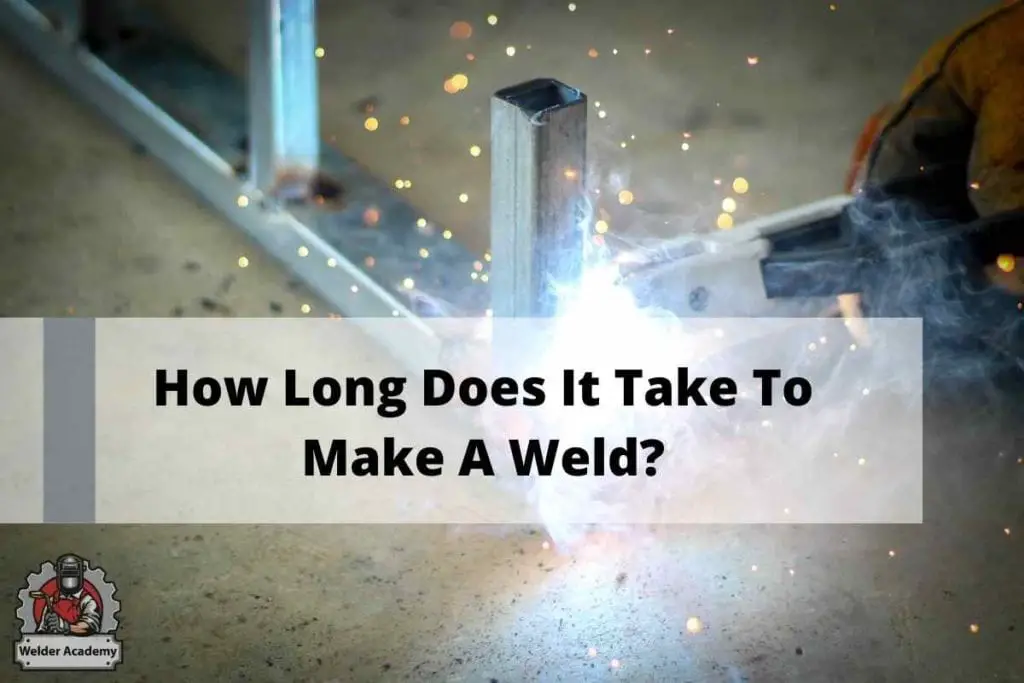Welding can be an intricate form of art that comes with its fair share of benefits and drawbacks. One thing is for sure when it comes to deciding how much time welding takes, it’s quite a fast process in terms of learning and execution. A common question lingers in the minds of many just like you, which is: how long does a weld take?
On average, a trained welder can weld about 140 inches per hour. These inches of weld amount to about a full pipe diameter of the weld. Some welds can take as long as it’s necessary, depending on the available equipment, area coverage, and so on.

The topic of correlating welding with time is quite subjective. Welds can take the time or be done quickly based on various factors. In this article, I will be discussing tips on how to weld faster, so keep reading!
How Long Does It Take On Average To Make A Weld?
Any in-house welder with the proper equipment and training can cover welds about 140 inches within an hour. However, this varies depending on the size of the objects being welded, the number of welds needed, the type of equipment used, and the technique of welding.
Any in-house welder with the proper equipment and training can cover welds of about 140 inches within an hour. However, this varies depending on the size of the objects being welded, the number of welds needed, the type of equipment used, and the technique of welding.
Nevertheless, the art of welding is quite delicate, but it’s not a process that takes time. The whole purpose of welding is to make sure things are connected as fast as possible. To give a brief explanation, welding is a manufacturing method that uses heat, pressure, or both to connect two or more pieces.
Welding is mostly done on metals. However, you can also weld wood and thermoplastics. Welding is the art of connecting materials with ease, and it can come in many forms, such as arc, friction, laser, resistance, etc.
Depending on the type of welding you choose, the time it may take to finish a single weld, be it on a bicycle frame, exhaust, or pipeline will vary.
This is especially noticeable if you let a group of welders weld an exhaust in ideal conditions. Most welders will take an average of 20 minutes. However, if you give each welder separate equipment, then the results will show a different pattern. For example, a MIG welding machine does the job faster than a TIG welding machine.
This also depends on the skills and the type of weld made by the welders. However, no welding job outdoors in your garage will take more than an hour for a single weld. This includes both the pre-preparation and the cooling process altogether.
Unless it’s underwater welding, that is surely going to take time. However, you would want to do it as fast as possible because, let’s be honest, nobody wants the oxygen cylinders to run out!
Conditions are a vital factor as well. Sometimes your weld may cool off earlier, or sometimes it’ll take its time. The amount of welding power you provide is also crucial.
Tips On How To Weld Faster
Let’s talk about various tips on how welding can be made faster. Welding is a complicated process, and also quite an exhausting and excruciating one. Just like your workout sessions, you most likely want it to be over as soon as possible.
However, there is no need to worry because I have your back and I’m about to give you some pointers on how to do it faster and properly!
Thus, without further ado, let’s jump straight into the tips:
Tip 1: Resorting To MIG welding
If TIG welding, gas welding, and other types of welding are not fast enough for you, then you will be glad to know that MIG welding is an ally.
MIG welding can provide a cleaner, quicker weld that may be applied to a variety of metals, including aluminum and other softer metals. MIG welding’s sole disadvantage is its complexity. To accomplish this, I suggest that you start using a constant stream of inert gas, direct currents, and precise control of the torches.
MIG welding emits only carbon dioxide (CO2). Moreover, it is cost-effective and also produces welds that will stick for quite a while. You may also use a mixture of argon and helium to get a proper hold.
In general, the most effective advice for speeding up the welding process is practice. By concentrating on honing your technique, you will quickly be able to produce a clean, strong weld.
Tip 2: Preparing Your Equipment And Settings Properly
The perfect setup may make a significant difference in how quickly a welder can work. Making the effort to ensure that you have the proper welding setup, welder settings, and electrode selection will help you save time on your next welding project. Let’s be honest, how many of us are willing to risk doing the same task twice by not properly adjusting everything?
Not only will it save you time in the long run, but it will also make you efficient. Hence, testing your weld on a scrap piece of metal before using it on the main piece is a wise decision. Having to redo a weld is exhausting and not very economical.
Tip 3: A Skilled Worker Always Stays Vigil
Avoid moving too quickly during welding, especially when using MIG or stick welding. However, while this tip may seem counterintuitive to becoming a rapid welder, this is not the case. If you work too quickly, you can cause a variety of problems, including insufficient penetration, a visually cluttered weld, and/or drooping of the weld joint.
Time Required For Welds To Cool Down
Cooling down of infused materials is a vital part of a weld being made fast. Hence, many might ask about the amount of time that welds may take to cool down. If we let nature take its natural course, then the time required won’t exactly spell “fast.”
For example, natural cooling takes about 48-50 hours to cool a 25-ton stainless coil from 750 °C to 50 °C. As we know, all types of welding require a high amount of heat to be supplied to the joints made. Thus, this makes the process a lot harder than one can imagine.
Depending on the cause and technique of the heating (welding, for example), you may wish to quench the workpiece rather than wait for it to cool naturally. There are many specific cooling techniques. You could use a furnace, air conditioner, water, or even oil to cool your weld. Air cooling takes 12–17 minutes, while oil or water quenching takes less than 4 minutes.
To reduce carbide precipitation along grain lines, it is best to quench cold stainless steels, at least austenitic series alloys. There are many other forms of cooling techniques that depend on the materials you are looking forward to cooling.
Finally, the time it takes for a piece to cool naturally depends on its size, thickness, and the temperature it was heated to. Regardless of these circumstances, an aluminum component will cool faster than a stainless steel piece.
Conclusion
I hope this article answered your question: how long does a weld take? This question is a very subjective and variable aspect of welding in its own right. A lot of factors kick in that will determine the time it’ll require to finish the weld. Thanks for stopping by!
However, I will suggest you practically apply the knowledge you have attained from this article. This will surely boost your welding time and make it more efficient for you to finish your work.
